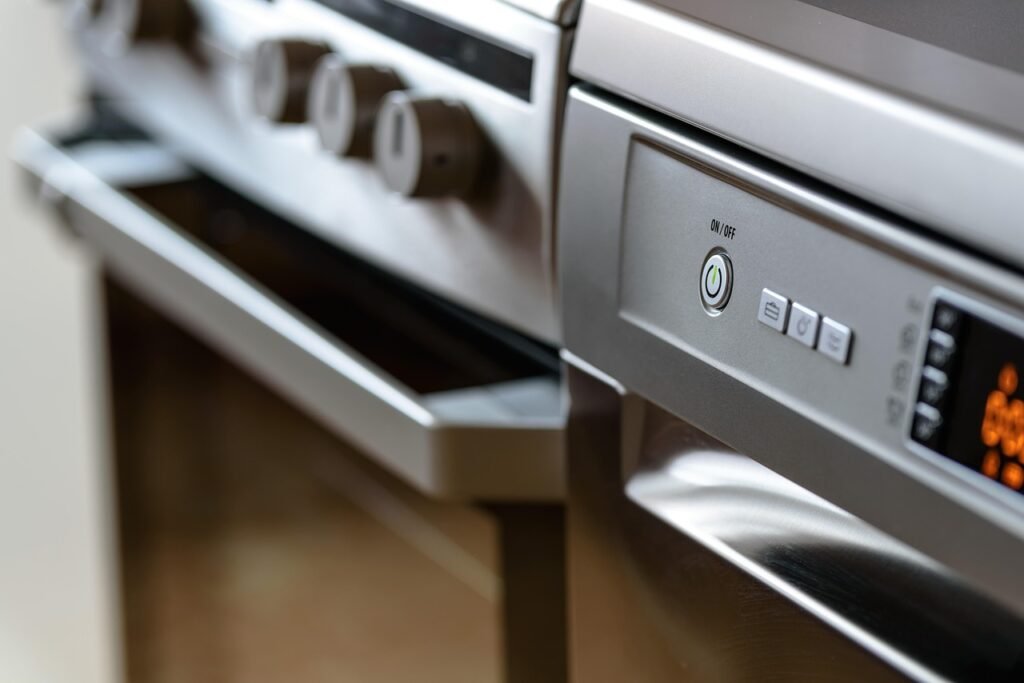Your kitchen feels like the heart of your home, but it’s also one of the biggest energy drains. Appliances run constantly, and kitchen lights (despite natural daylight) still get heavy use, adding up to more energy than most people realize.
In fact, the U.S. Energy Information Administration reported in 2024 that kitchens and laundry areas make up nearly 30% of household electricity use. That means the way you use your kitchen really matters for your wallet and for the planet.
Your kitchen might not feel like an energy hog, but the waste often hides in plain sight. It’s in the hum of an overworked fridge, the glow of outdated bulbs, and the small habits you’ve repeated so often they feel normal. Once you know what to look for, these signs are easy to spot—and even easier to fix.
1. Your Fridge Is Old or Inefficient
If your fridge is over 10 years old, it’s probably costing you more than you think. Modern energy-efficient models use around 200 to 600 kilowatt-hours (kWh) a year depending on the size, but older units can burn through 800 or more.
According to ENERGY STAR’s 2024 report, certified fridges cut energy use by at least 9% compared to the models that meet the federal minimum energy efficiency standard . That adds up to hundreds of dollars over their lifetime.
Your habits also play a role. A fridge packed too tightly blocks airflow, while one that’s nearly empty forces the motor to cycle more often. The sweet spot is keeping it about three-quarters full and set to 37–40°F (3 to 4°C).
Maintenance matters too: dirty coils and broken seals make the compressor work harder than it should. Even small tweaks, like closing the door quickly or fixing a faulty gasket, can reduce waste and keep your fridge from silently draining your budget.
2. You’re Leaving Appliances Plugged In
You might think appliances stop using power when you switch them off, but many keep drawing what’s known as “phantom energy.”
Microwaves, coffee makers, and even phone chargers all sip electricity while sitting idle. The U.S. Department of Energy confirmed in 2024 that standby power can account for 5–10% of a household’s total electricity use. In a kitchen filled with gadgets, that adds up quickly.
The fix is surprisingly easy. Start unplugging devices when you’re not using them, or plug them into a power strip with a single off switch. It takes two seconds and can save you both money and wasted watts.
When buying new appliances, check for low standby consumption or eco modes that cut down on phantom energy. Cutting this hidden drain is one of the simplest ways to make your kitchen instantly more efficient.
3. You’re Using Big Appliances for Small Jobs
Heating up a full oven to warm leftovers or bake a single cookie is like using a fire hose to water a houseplant. It gets the job done, but it’s wildly inefficient.
A 2024 analysis by the UK’s Energy Saving Trust showed that microwaves use up to 80% less energy than ovens for the same cooking task. Air fryers and toaster ovens also deliver crisp results at a fraction of the cost.
The key is matching the appliance to the meal. Use the microwave for reheating, the toaster oven for small bakes, and save the oven for batch cooking. It’s not about giving up your favorite roast dinners, it’s about choosing smarter tools day to day. When you start cooking this way, you’ll notice your energy bills dip without even changing what you eat.
4. Your Lighting Is Outdated
Kitchens are notorious for being overlit with old bulbs that guzzle electricity. If you’re still using incandescents or halogens, most of their energy is being wasted as heat.
LEDs consume up to 90% less energy than traditional bulbs and last 25 times longer. That means switching to LEDs isn’t just good for the planet; it pays for itself quickly.
The fix is obvious but often overlooked. Replace your most-used bulbs first, especially in ceiling fixtures and over work areas. Add under-cabinet LEDs for better visibility without cranking overhead lights all evening.
And don’t underestimate simple habits like switching lights off when you leave the room. With power costs rising, lighting upgrades are one of the cheapest and fastest energy wins you’ll find in your kitchen.
5. You’re Cooking Inefficiently
The way you cook matters almost as much as the appliance itself. Using a burner that’s bigger than your pan wastes up to 40% of the heat, as per Energy.gov.

Leaving lids off pots, boiling too much water, or opening the oven door constantly forces your stove or oven to work harder than needed. These small habits often go unnoticed, but they burn through power day after day.
The fixes are easy. Match your pan to the right burner, and always keep lids on pots to trap heat. Use the oven light instead of opening the door every few minutes. When boiling water, measure only what you need instead of filling the whole pot.
Over time, these tweaks shave noticeable amounts off your energy use without changing the meals you love.
6. Your Dishwasher Habits Waste Energy
Dishwashers are more efficient than washing by hand, but only if you use them wisely. Running half loads or pre-rinsing under hot water can waste gallons of water and heaps of electricity.
According to ENERGY STAR’s 2024 report, certified dishwashers save an average household about 3,870 gallons of water over their lifetime compared to hand washing. But the real savings come when you run them properly.
Load it fully before starting, and skip the pre-rinse. Thankfully, modern machines are designed to handle stuck-on food. Use eco or energy-saving modes whenever possible, and switch to air dry instead of heat dry.
A few small adjustments like these cut down on both energy and water waste. Plus, they extend the life of your dishwasher by reducing unnecessary strain.
7. Your Freezer or Fridge Is in the Wrong Spot
Location matters more than most people think. If your fridge or freezer sits next to your oven, dishwasher, or in direct sunlight, it’s working overtime to stay cool. In fact, fridges placed near heat sources use up to 15% more energy. That’s money leaking away every time you preheat your oven or run the dishwasher beside it.
The fix might be as simple as shifting your layout or at least adding space between appliances. Make sure there’s room behind the fridge for air to circulate, and clean the coils to keep heat from building up.
Even small changes in placement can make your fridge’s job easier. If moving it isn’t an option, simple tricks like adding a shade over a sunny window can still cut the load.
8. You’re Ignoring Maintenance
Appliances aren’t “set it and forget it.” Over time, dust builds up on fridge coils, seals wear out, and filters clog. A dirty condenser coil alone can increase your fridge’s energy use by 30%. It’s the kind of hidden waste you don’t notice until your bills creep higher for no obvious reason.
Luckily, maintenance is simple. Clean fridge coils twice a year, and check door seals with the paper test. A loose seal lets cold air escape. Also, defrost freezers when frost builds up and replace clogged filters in water dispensers.
Again, these quick routines don’t just save energy; they also extend your appliance’s life. Think of it as preventative care for your kitchen.
9. You’re Heating Water the Wrong Way
Boiling water seems harmless, but the way you do it can make a big difference. Using a full pot when you only need a cup or leaving the lid off forces your stove to waste heat.
In 2024, the UK’s Energy Saving Trust reported that switching from stovetop to an electric kettle for daily boiling tasks cut energy use by up to 50%. For tea drinkers or pasta lovers, that’s a major hidden drain.
The fix is straightforward. Use the right-sized pot, keep lids on, and boil only what you need. Consider investing in an efficient electric kettle if you don’t already have one. It’s faster, cheaper, and a small switch that saves surprising amounts of energy over time.

10. Your Appliances Are Outdated Altogether
Even with good habits, old appliances eventually become a burden. Standards improve every year, and what was “efficient” a decade ago is wasteful today.
ENERGY STAR’s 2024 guide showed that new certified cooking appliances use about 18% less energy than standard electric models, while the most efficient refrigerators save 9 to 30% more than the federal minimum. That’s not marketing fluff but tested performance.
If your appliances are nearing the end of their lifespan, replacing them isn’t just about style. It’s an investment that pays back in lower bills and fewer repairs.
Look for ENERGY STAR labels and compare yearly energy use before buying. Even if the upfront cost is higher, the savings over time usually make it the smarter financial choice. With rising energy costs, an upgrade can quickly pay for itself.
Conclusion
Your kitchen doesn’t have to be an energy trap. From unplugging idle gadgets to rethinking how you cook, small shifts add up to real savings. Even tackling just two or three of these signs can lower your bills and lighten your environmental footprint. Every watt saved is one less burden on your home and on the planet.




I like this post, enjoyed this one thanks for posting. “Fear not for the future, weep not for the past.” by Percy Bysshe Shelley.
This is the proper blog for anyone who wants to search out out about this topic. You understand so much its virtually hard to argue with you (not that I truly would need…HaHa). You positively put a new spin on a topic thats been written about for years. Great stuff, just nice!
I am only writing to let you know what a great discovery my cousin’s girl found studying your web site. She mastered lots of details, not to mention how it is like to possess a great giving mood to let folks with ease know certain extremely tough things. You actually exceeded our expected results. Many thanks for giving the necessary, trusted, revealing and as well as easy tips about this topic to Jane.